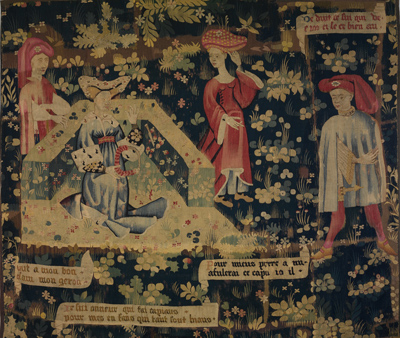A Green Place to Rest
Between the level turf and the herbs let there be a higher piece of turf made in the fashion of a seat, suitable for flowers and amenities; the grass in the sun???s path should be planted with trees or vines, whose branches will protect the turf with shade and cast a pleasant refreshing shadow.
???Book VIII, Chapter I: “On small gardens of herbs.” Piero de’ Crescenzi, Liber ruralium commodorum (1305-09). (See Catena, the Bard Graduate Center???s Digital Archive of Historic Gardens and Landscapes for more information.)
Above: Honor Making a Chaplet of Roses, ca. 1425???1450. South Netherlandish. Wool warp, wool wefts; 93 x 108 in. (236.2 x 274.3 cm). The Metropolitan Museum of Art, New York, The Cloisters Collection, 1959 (59.85). See the Collection Database to learn more about this work of art.
Turf benches were among the most distinctive features of medieval gardens, and are depicted in many paintings and tapestries. Such benches may be rectangular, circular, L-shaped, or U-shaped; the U-shaped type is known as an exedra. Regardless of their shape, the benches were usually constructed with low-walled frames made out of brick, wood, stone, or wattle (woven willow). The frames were then filled with soil and the surfaces were topped with turf. Turf seats were placed in the middle of the garden or against one of its walls, and were sometimes incorporated into the enclosure. Arbors or trellises were sometimes built into the seat to provide shade and shelter, while circular benches were constructed around single trees. Read more »

